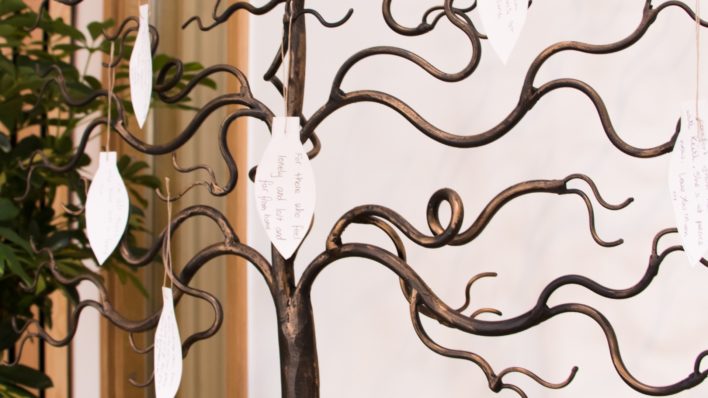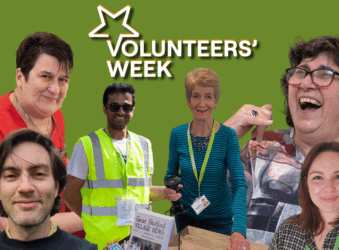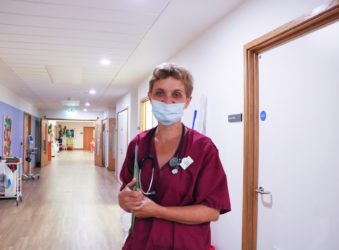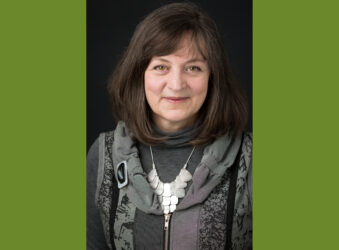An Unexpected Chapter – The Patient & Family Support Team
Share this article

Anyone who has visited our Hospice knows that no two days are the same. This was taken to a new level earlier this year when it was necessary to put COVID-19 precautions rapidly in place.
We took some important time to reflect on these changes and ‘An Unexpected Chapter’ in our Hospice’s history.
An Unexpected Chapter for our Patient & Family Support Team. Part 1 – Keeping our services running
Our Patient & Family Support Team offer practical and emotional support to patients, relatives and friends, including psychological support, social support, spiritual care, counselling and bereavement support.
We spoke to Team Lead and Hospice Chaplain Keith Morrison, about what we have done to keep our Patient and Family Support Services running, since COVID-19 changed everything.
How things used to be…
Before the Coronavirus pandemic, psychological assessment and sessions for our patients, their family and friends would usually be provided in person, at the Hospice in one of the private clinic rooms in the Bradbury Wellness Centre.
The team’s social worker supports patients on the Inpatient Unit. She has always provided this service in person.
Previously, Chaplaincy and spiritual support was provided primarily in person – with occasional phone calls and emails, depending on the individuals’ needs – to patients and families on our Inpatient Unit and to those in their own homes being supported by the Arthur Rank Community Team.
We also hosted a monthly Bereavement Group at the Hospice, face to face, with individuals each attending twelve times. Previously, the group would support around fourteen members at each session.
How we’ve adapted…
When the Coronavirus pandemic hit in March 2020 we had to temporarily halt many of our face to face services, rapidly moving support to phone or video calls. The personal touch can be lost through these methods of communication, so we were always keen – and have started – to reintroduce in-person meetings when possible and where clinical need dictates.
Psychology team
Previously the majority of our one-to-one psychological support was given in person at the Hospice, with initial assessments also taking place in this way.
During the first wave of the pandemic and due to the government’s guidance, we had to cease face to face appointments almost immediately. Sessions were instead offered over the telephone or via video calls.
As restrictions eased through the summer, and where there was a need, we were able to offer face to face appointments once more, although initial assessments continue to be carried out over the telephone. We continued with this approach as we navigated the restrictions of the second lock-down.
Social worker
Our social worker continued to offer support to patients on our Inpatient Unit and their families, face to face on the ward. Her work involves her contacting external agencies over the phone and on email, and this has continued during the pandemic, as it always has.
Chaplain & spiritual support
Spirituality is very much tied in with who a person is and can be where they find, or look for, meaning to the ‘big questions’. For some this becomes even more important as they approach the end of their life.
When restrictions were introduced for the first lock-down, it was therefore vital that we continued to provide spiritual support to those who wanted or needed it. Nothing is quite the same as receiving a visit in person, particularly at this stage of life, so we continued to meet those we were supporting face to face as needs dictated, and if the patient was happy to do so. For some a phone call sufficed.
Whilst we had to pause our Chaplaincy volunteers visiting the Hospice for a while during the first lock-down, I continued to visit those on our Inpatient Unit needing support, in-person throughout the pandemic. Chaplaincy volunteers were able to restart their visits into the Hospice in August.
I continued to visit those patients who were being supported by our Day Therapy and Community Teams in their own home, where there has been a need. Demand has increased over this time, partly because other support structures have stopped working. This has averaged around two or three patients per week, since about May which is more than previously.
Bereavement Support Group – monthly
During the first wave of the pandemic and due to the government’s initial lock-down measures, we were forced to immediately move these sessions to video calls via Zoom or one-to-one telephone calls.
The Group continued to support a group of fourteen entirely on Zoom ever since April. More recently – since restrictions eased towards the end of the first lock-down – we have been able to support a group session with eight members in the Hospice building (which is COVID-secure) with any additional members on Zoom, rotating between those who wish to come in.
Innovation and learning…
One thing that I’ve been surprised by and which I’m grateful for is how quickly we have been able to change our way of working and adapt to this completely new situation and set of circumstances.
Even older adults, for example, are now using Facetime and Zoom to keep in contact not with only us, but also family members. For some, the Hospice has assisted them in opening these new avenues of communication, making a real difference not only for now, but for the future too.
The patient’s point of view…
Initially there was some reluctance to using online video calling methods like Zoom and MS Teams. However, I think people quickly realised that this method of us supporting them was better than not at all, and many have been willing to try before then agreeing to join online groups and sessions.
We did notice that the number of people being referred for psychological support initially dropped slightly during COVID, but then soon increased to previous levels. Regular contact with those who required bereavement support was maintained.
Challenges…
People hesitate and can be very uncertain of change and new ways of working but we have seen colleagues and patients coming round to these new methods of providing care and support.
I still much prefer to do my work face to face where possible: it is not all about the words used in a conversation; sometimes body language can play a massive part in conversation. Where a patient is very ill, being there in person can be a great comfort to them and their family: I can feel and sense more, if I am able to meet them face to face and vice versa.
Something else that has been really hard for patients and their families and something they often share with us and want to talk through, is when they perceive that the pandemic has prevented them receiving medical treatments they need, or has caused a delay. This can be difficult for both the individual and their family members, especially when the time they have left is so precious.
Our team has done their best to support patients and families where they can, not only through helping them access the care and support that they need, but also by providing a listening ear to their frustration, grief, sadness and anger, which has often been amplified because of the pandemic.
Opportunities and what’s next for the team…
Despite the challenges the team has faced over the last seven months, we now know that we have a range of methods by which we can extend our range of Patient and Family Support Services to those who are unable to visit us in person. This is something we hope to explore further as we continue to support our patients, their families’ and the health needs of the Cambridgeshire community as a whole in 2021.
Read ‘An Unexpected Chapter – Inpatient Unit’
Read ‘An Unexpected Chapter – Day Therapy’
Read ‘An Unexpected Chapter for our Director of Fundraising and Communications
Related articles
-

Hospice Volunteers recognised during National Volunteers Week 2025
Arthur Rank Hospice Charity says thank you to over 600 volunteers
-

Bistro Buddies … ‘Something to look forward to’
‘Bistro Buddies’ share how their strong and supportive friendships bloomed from a ‘very sad situation’
-

COVID-19: overview clinical services
Summary of clinical services, which will continue with current models
-

Join us online for our annual lecture, with best selling author
Kathryn Mannix, author of award winning book 'With the End in Mind', joins us on 19 October




